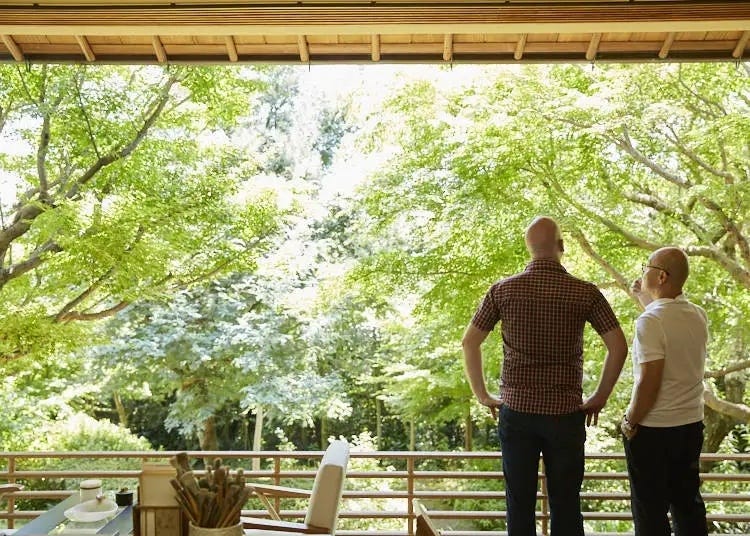
Our journey this time takes us on a relaxing day trip from Tokyo to Miura Peninsula’s Hayama Town. Hayama holds a significant place in history as the former residence of early Western ambassadors to Japan, with several of their homes still preserved.
Experience the soothing sea breeze and delve into Japan's intriguing historical connections with the West, led by Mr. Tetsu Morita, a key contributor to the esteemed Michelin Green Guide Japan. Assisting him on this adventure is Timothy, an editorial staff member from LIVE JAPAN hailing from New York State.
Starting off in Hayama Town
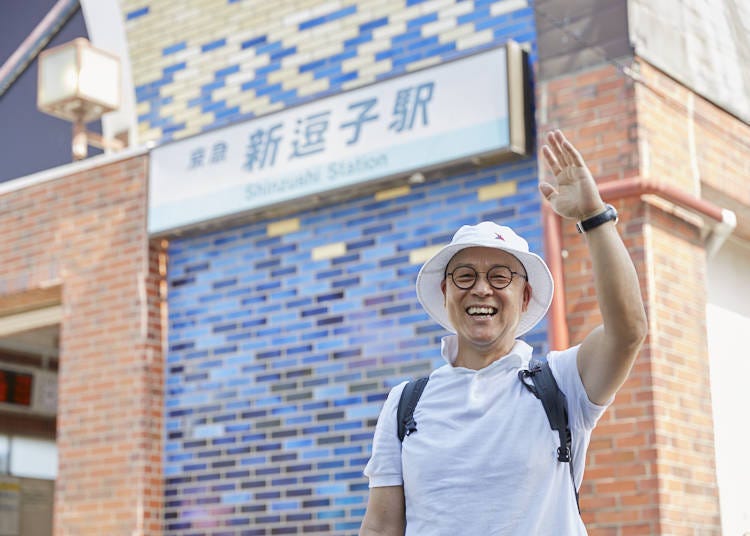
Morita-san conveniently boarded the Keikyu Zushi Line, making his way to Shinzushi Station (now known as Zushi-Hayama Station), where he met up with Timothy.
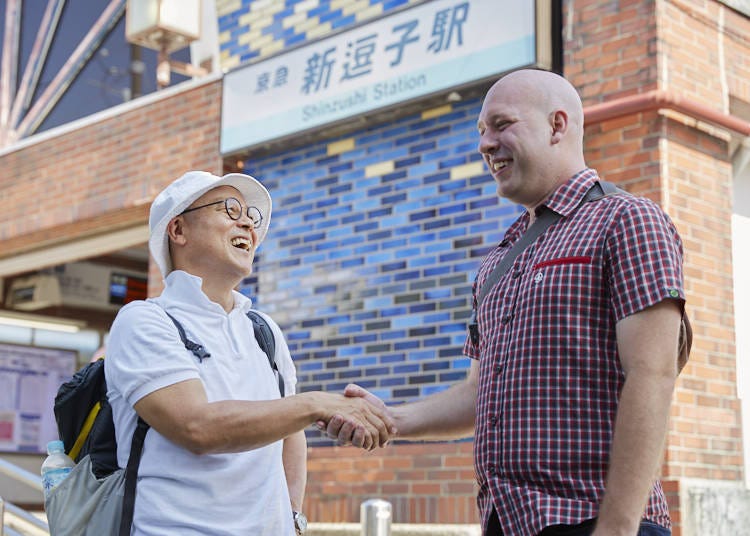
Timothy greeted Morita-san with a cheerful "Good morning!"
Morita-san responded warmly, saying, "Hello, Timothy! I'm excited to take you on a tour of Hayama Town today. It's a delightful place with numerous captivating attractions that I'm certain you'll find enjoyable. But first, let's grab a bite to eat. I know just the perfect restaurant!"
LA MARÉE: Pure Relaxation at a French Terrace Restaurant Serving Fish and French Cuisine
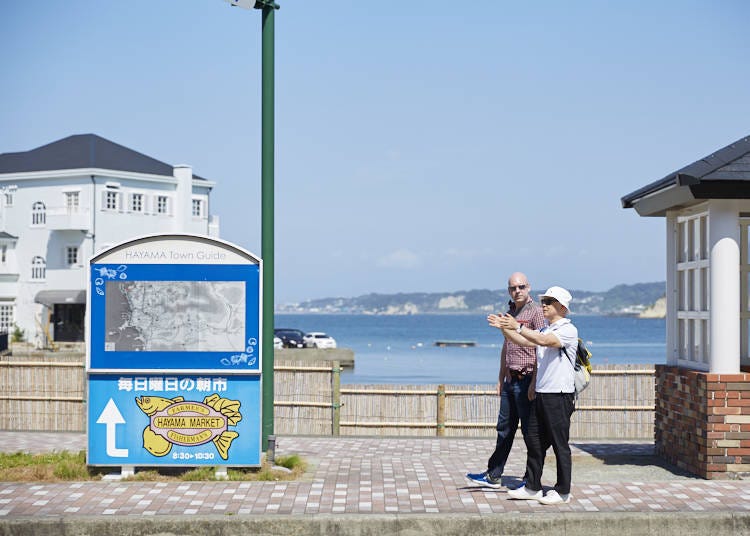
Our journey continued as we hopped onto the Keikyu Bus from Shinzushi Station, heading towards Yoroisuri Bus Stop. Stepping off the bus, we were immediately greeted by the breathtaking vista of the Obama coast.
Timothy couldn't contain his admiration and remarked, "What a marvelous place! The juxtaposition of the Western-style buildings against the backdrop of the sea reminds me of the French Riviera."
Morita-san, eager to share the town's history, explained, "Hayama used to be a typical fishing village, like many others found across Japan, until about 130 years ago. However, in 1876, the arrival of the German doctor Erwin Bälz was followed by the 5th Italian Minister to Japan, Renati de Martino, in 1883."
"Both of them developed a fondness for Hayama and decided to build holiday residences here. Their high praise attracted other European ambassadors, who also constructed private summer retreats in Hayama. As a result, Western culture took root in the town, and even today, the nostalgic ambiance of those bygone days can still be felt. It's a haven for European visitors yearning for a seaside setting steeped in history," Morita-san added.
Timothy pondered and replied, "So, the Meiji Period brought the influence of Western lifestyle to Hayama."
"Exactly," confirmed Morita-san. "That's what makes Hayama such a fascinating town, with its refined atmosphere and scattered European remnants that have turned it into a popular sightseeing destination. While Hayama shares its coastline with Shonan and Enoshima, it exudes a distinct charm of its own. It's the ideal place for leisurely and relaxing sightseeing."
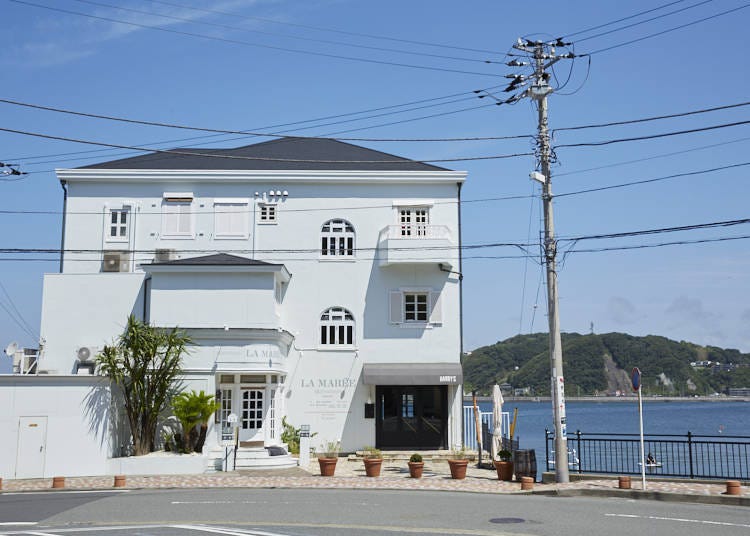
Morita-san pointed out a remarkable European-style house called "La Marée," constructed in 1977. The name itself, meaning "sound of the sea," perfectly captures its essence.
As visitors step onto the terrace, they are treated to a captivating view of the water while indulging in their dining experience. The ground floor houses a laid-back café and brasserie, making it an excellent choice if you simply wish to unwind with a refreshing beer.
"I highly recommend grabbing a seat on the terrace. Personally, I frequented this place during its early days, and I have cherished memories of sitting here, sipping cocktails, listening to the soothing waves alongside a woman who taught me French."
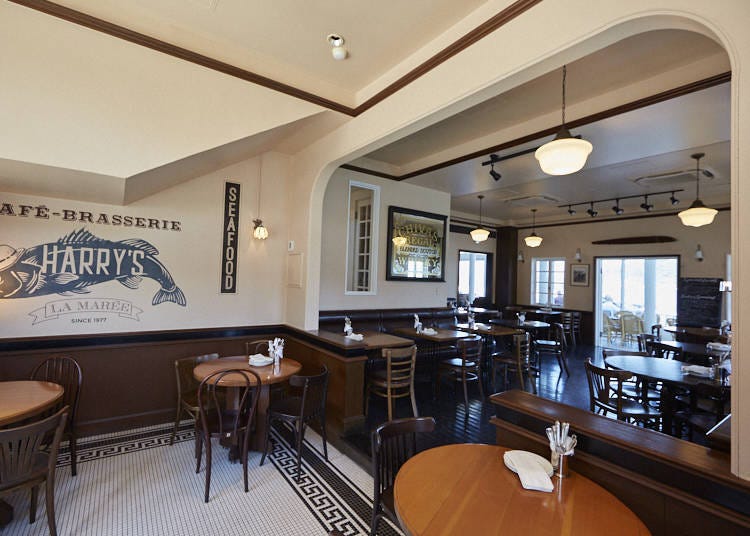
Morita-san continued, saying, "If you're seeking a chic atmosphere to relish wine and creatively crafted French-inspired seaside cuisine, I highly recommend visiting the second floor. It offers an exquisite dining experience. And for those interested in hosting dinner parties or other special events, the third floor houses a stunning banquet room that can be rented. It provides a beautiful setting for any occasion."
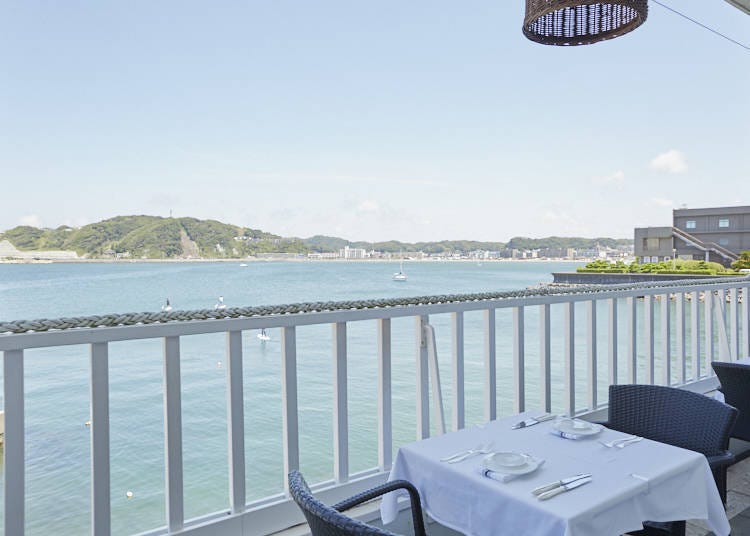
Timothy chimed in, "I love the view from the terrace. Many of my friends adore these types of seats, where they can enjoy the beauty of the sea, feel the gentle breeze, and listen to the rhythmic waves while enjoying drinks and a good meal. Why don't we enjoy our lunch outside today?"
Morita-san added, "Let's! And from here, you can really enjoy the Zushi coast, extending all the way to Enoshima and Chigasaki. On sunny days, you might even catch a glimpse of Oyama, Hakone, the Izu Peninsula, and, occasionally, the majestic Mount Fuji. There's nothing quite like the view of snow-covered Mount Fuji on a clear winter day. It's truly a sight to behold."
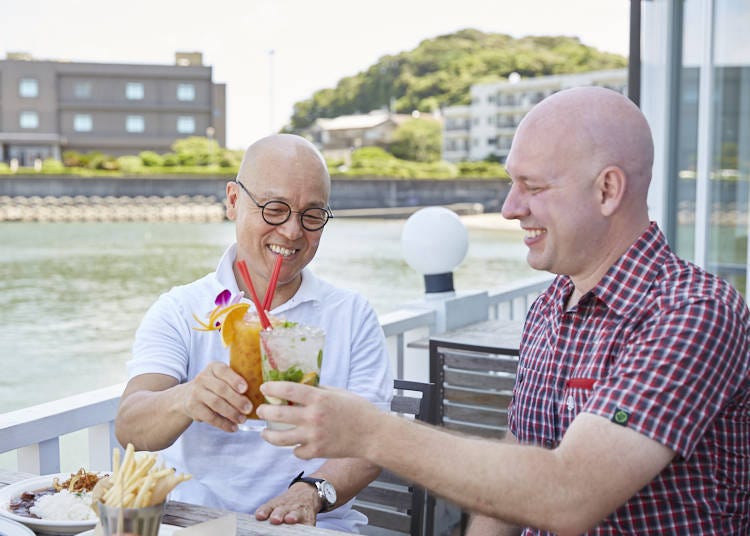
To kick off their Miura day trip, the duo raised a toast with refreshing non-alcoholic cocktails. They opted for the tropical mango iced tea (864 yen) and the invigorating mint cooler (864 yen). For lunch, they selected two of La Marée's crowd favorites: the flavorful Hayashi Rice and the tantalizing Cheeseburger.
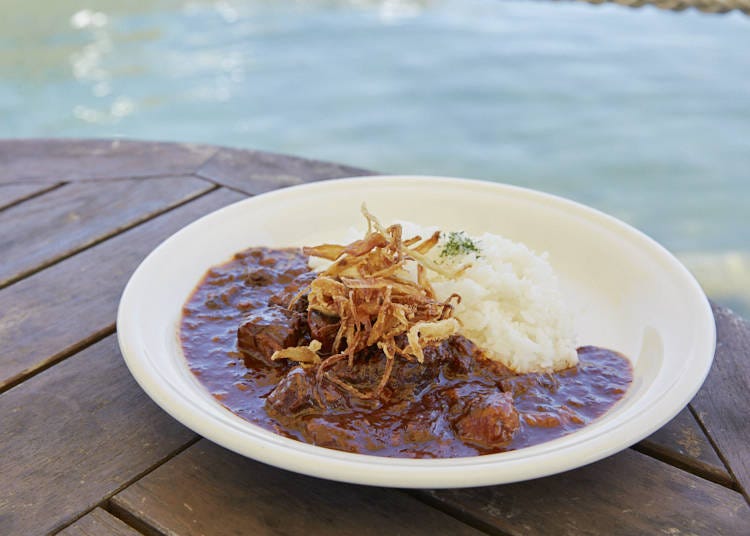

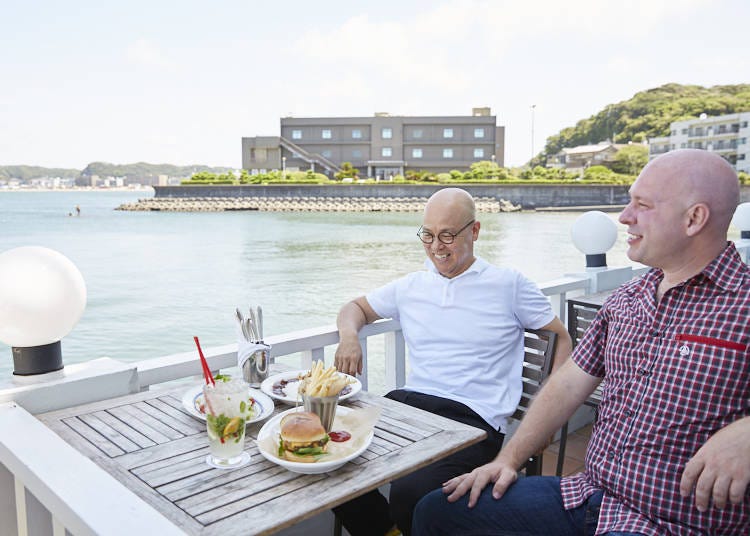
The gentle breeze and the soothing sound of the sea created a fantastic ambiance, perfect for savoring delicious food. The delightful atmosphere not only enhanced their dining experience but also sparked lively conversations between them.
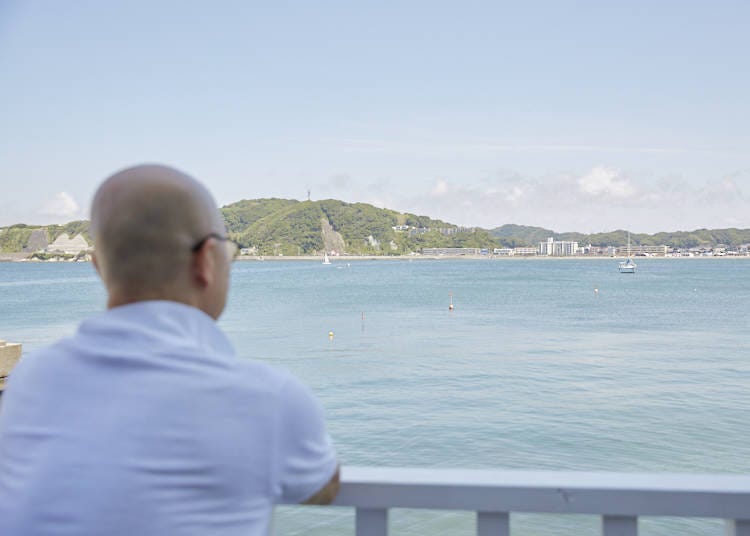
Morita-san remarked, "This café is an ideal spot to take a leisurely break in the afternoon. It's the perfect place to sit down, unwind, and write a heartfelt postcard, sharing the wonderful memories you've created here in Japan with your friends and family back home."
As Morita-san and Timothy enjoyed their fantastic lunch, they found themselves leisurely gazing out at the ocean. The tranquil atmosphere seemed to make time slip away, allowing them to fully immerse themselves in the moment.
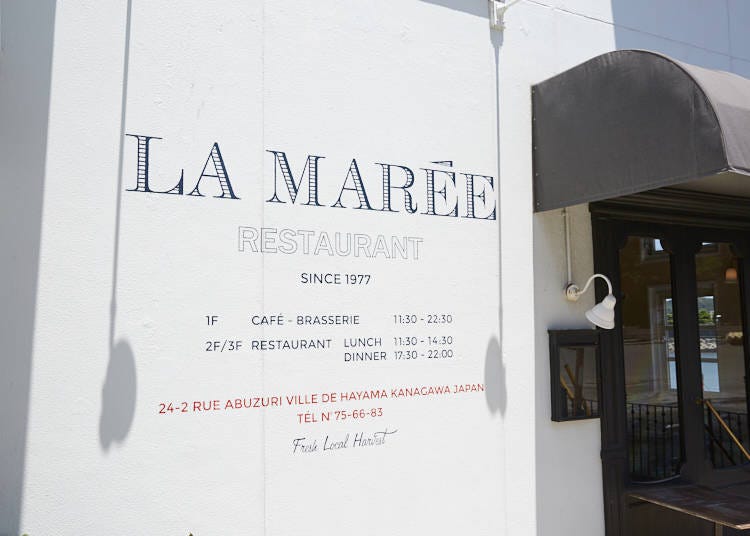
-
La Marée Restaurantレストラン ラ・マーレ
- Address 24-2 Horiuchi, Hayama, Miura Bezirk, Kanagawa 240-0112
-
Nearest Station
Access: Shin-Zushi Station (Keikyu), then Keihin Kyuko Bus to Yoroisuri Bus Stop, 1 minute by foot
- Phone Number 046-875-6683
Closed: Mondays (open on national holidays, closed the following weekday)
1F Café & Brasserie Harry’s
・Hours (weekdays)
- Lunch: 11:30 a.m. – 2:30 p.m.
- Tea time: 2:30 p.m. – 5:00 p.m.
- Dinner: 5:00 p.m. – 9:00 p.m. (last order for food)
・Hours (Saturdays, Sundays, national holidays):
- Lunch: 11:30 a.m. – 2:30 p.m.
- Tea time: 2:30 p.m. – 4:00 p.m.
- Dinner: 4:00 p.m. – 9:00 p.m. (last order for food)
2F and 3F Restaurant La Marée
・Hours
- Lunch: 11:30 a.m. – 2:30 p.m. (last order for food)
- Dinner: 5:30 p.m. – 9:00 p.m. (last order for food)
Hoshun Yamaguchi Memorial Hall: Sinking Into the Serene World of Art at a Modern Atelier Loved by Japanese Art Pioneers
Having savored a delightful meal at La Marée, we hopped back on the Keikyu Bus to our next destination, the Hoshun Yamaguchi Memorial Hall. We alighted at the "Sangaoka / Kanagawa Kenritsu Kindai Bijutsukan Mae" bus stop and embarked on a leisurely stroll along the "Hoshun Komichi" path, leading us towards the mountains.
As we continued on the path, the Hoshun Yamaguchi Memorial Hall revealed itself, standing proudly right in front of us.
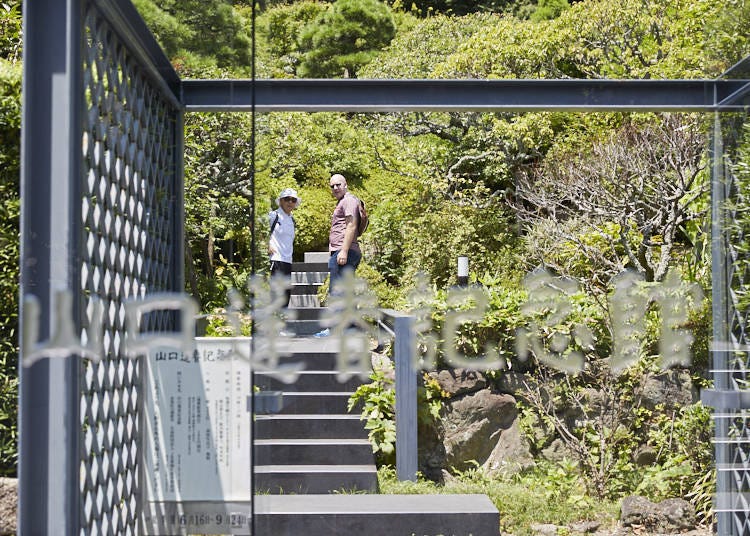
Timothy inquired, "Could you tell me more about Hoshun Yamaguchi and his artistic style?"
Morita-san responded, "Certainly! Hoshun Yamaguchi was a renowned Japanese Nihonga painter. Interestingly, he began his artistic journey by studying Western painting techniques. However, as he delved into Japanese painting, he developed his own unique style. Nihonga, in essence, is an art form that emphasizes traditional painting techniques predating the introduction of oil painting from Europe. It involves using materials such as silk cloth or washi paper instead of canvas, and the pigments are created by crushing minerals or shells, which are then mixed with glue."
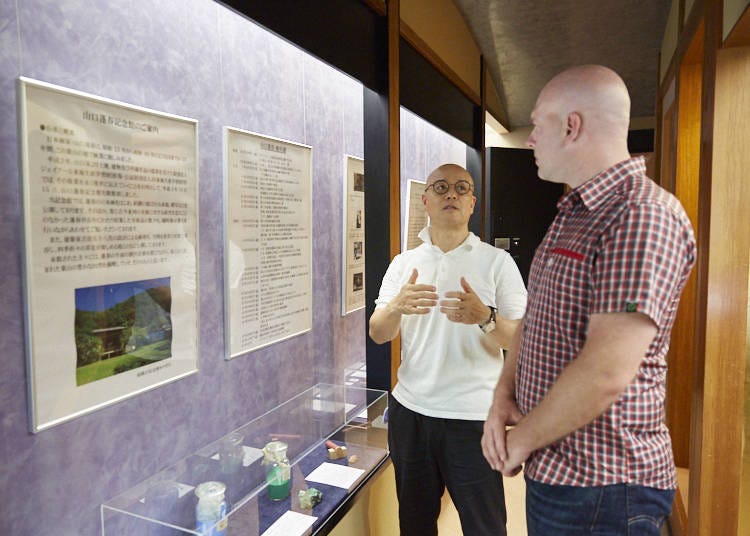
Morita-san continued, saying, "The Hoshun Yamaguchi Memorial Hall is a Japanese-style house that served as Hoshun's final residence, and his atelier has been preserved in its original state. The architectural design was skillfully executed by Isoya Yoshida, capturing the magnificent modern style of the Showa era. One notable feature is the splendid, large window, which maximizes the utilization of Hayama's abundant sunlight."
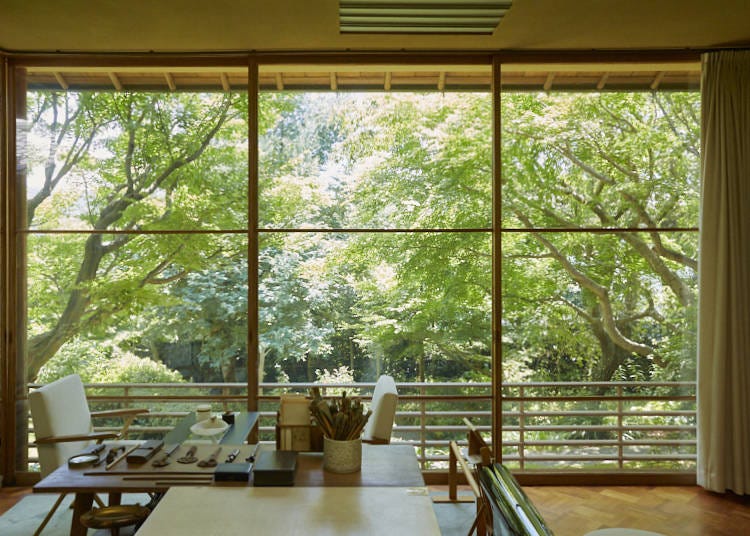
Morita-san pointed out, "Through this window, you can behold the exquisite garden that Hoshun and his wife dedicated much effort to maintain. Each season unveils a unique landscape, showcasing white and red plum blossoms, the elegant Bungo plum, vibrant mimosas, Japanese maple trees, the enchanting weeping cherry, and, of course, the vibrant hues of autumn."
Timothy agreed, saying, "Absolutely. I could easily lose myself in the mesmerizing view of this lush garden."
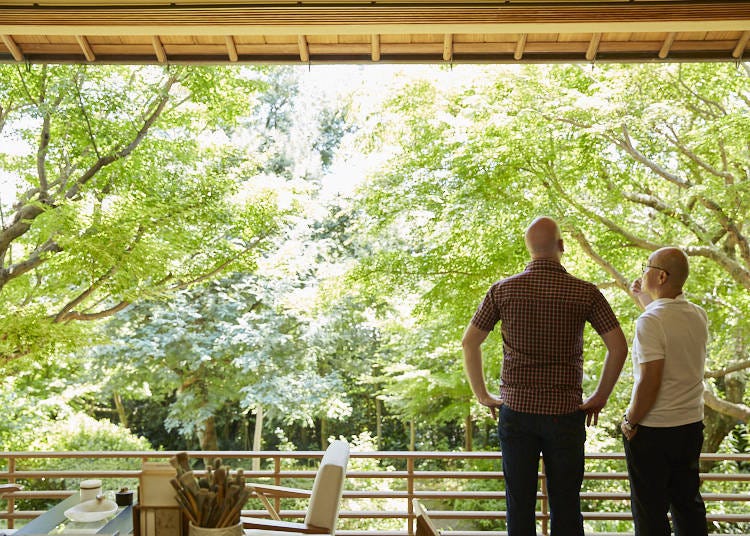
-
Hoshun Yamaguchi Memorial Hall山口蓬春記念館
- Address 2320 Isshiki, Hayama, Miura Bezirk, Kanagawa 240-0111
- Phone Number 046-875-6094
・Hours: 10:00 a.m. – 5:00 p.m. (last admission at 4:30 p.m.)
・Closed: Mondays (open on national holidays, closed the following weekday), between exhibitions, on maintenance days, New Year’s
Hayama Modern Art Museum: a Creative Space Where The Location Itself is One of the Artworks

Having thoroughly explored the Hoshun Yamaguchi Memorial Hall, our next destination was the Hayama Modern Art Museum, conveniently situated facing the sea. This art museum houses an impressive collection of approximately 1,400 contemporary artworks from both Japan and overseas. Throughout the year, visitors can enjoy a diverse array of exhibitions, including special exhibitions and collection showcases, which are held approximately eight times annually.
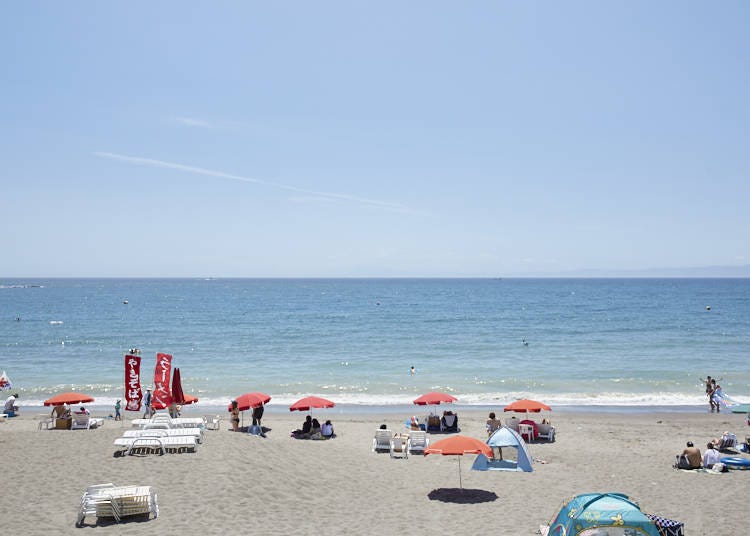
Timothy exclaimed, "Wow, you can actually see the beach and the museum's garden from here!" (The pictures were taken during summer.)
Morita-san nodded in agreement, saying, "Yes, that's Isshiki Beach, and it holds quite a reputation. There's a pathway located right beside the art museum that leads directly down to the ocean. I also highly recommend visiting the observation deck for a breathtaking view of the Pacific Ocean. If you're fortunate, you might even catch a glimpse of Mount Fuji on a clear day."
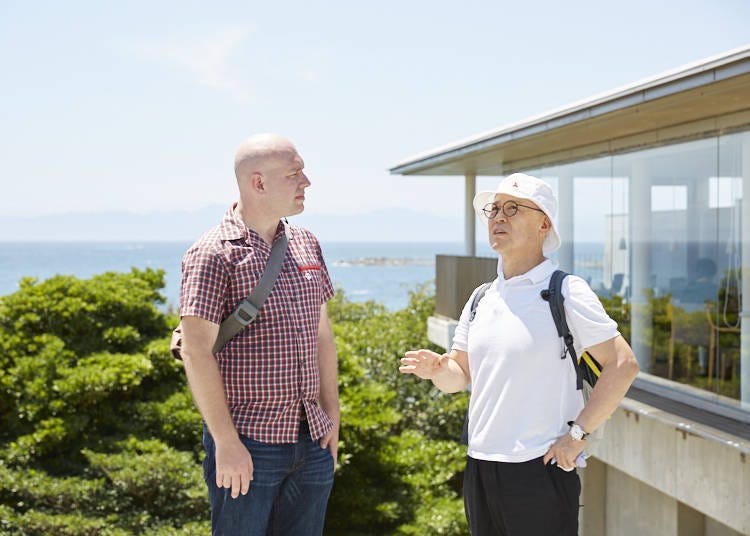
Morita-san mused, "The azure ocean, the towering pine trees, the pristine white beach, and the majestic Mount Fuji... Doesn't this scenery resemble a scene straight out of a Hokusai ukiyo-e print? It encapsulates the landscape that has been so iconic to Japan since the Edo period. If you wish to soak in this view a little longer, I recommend visiting the restaurant adjacent to the museum called Orange Bleue."
During our visit to the Hayama Modern Art Museum, we had the opportunity to explore the captivating exhibition titled "The Collection of National Museum of Ethnology — Shell Road" (though regrettably, it has since concluded). Co-sponsored by the National Museum of Ethnology in Osaka, this exhibition offered a profound perspective on the artistic and aesthetic allure hidden within shells and shellfish. It presented a fascinating journey into the artistry associated with these natural wonders.
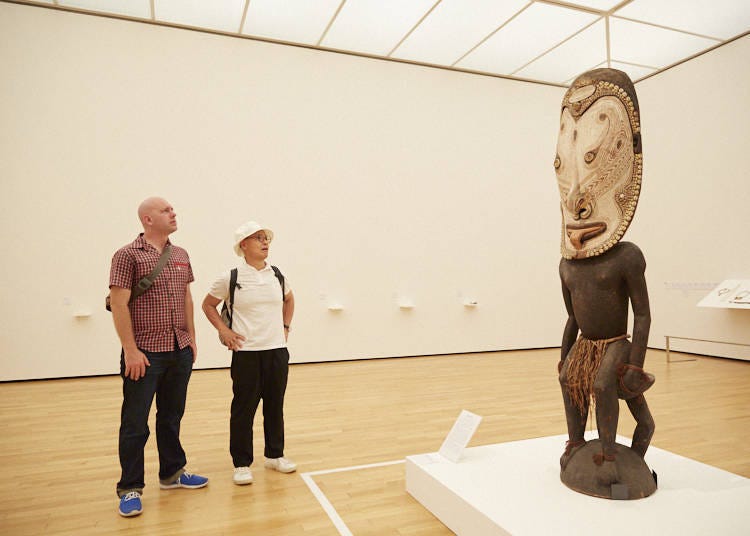
Morita-san shared his fascination, saying, "I find this collaboration with the National Museum of Ethnology truly captivating. It showcases how different ethnicities independently created art, accessories, tools, and more using shells and shellfish. It's a remarkable artistic challenge, isn't it? And Hayama itself is intimately familiar with such challenges. Having embraced European culture so early in its history, Hayama faced the task of coexisting and developing something truly unique."
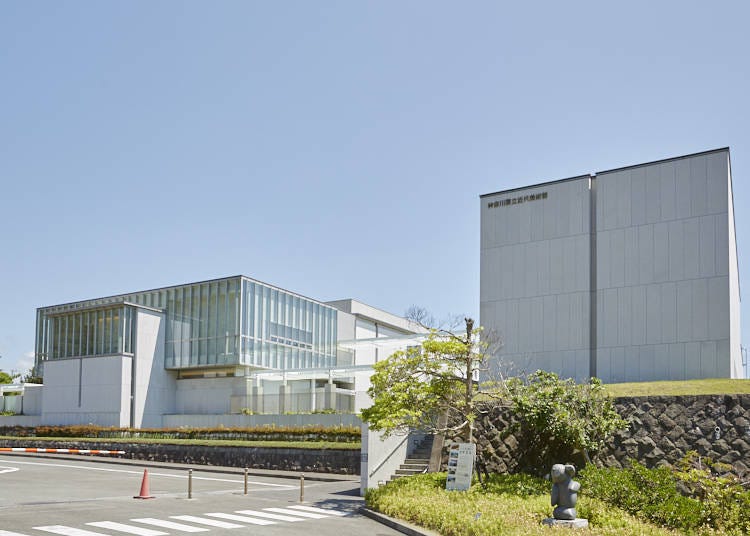
-
Hayama Modern Art Museum神奈川県立近代美術館葉山
- Address 2208-1 Isshiki, Hayama, Miura Bezirk, Kanagawa 240-0111
- Phone Number 046-875-2800
・Hours: 9:30 a.m. – 5:00 p.m. (last admission at 4:30 p.m.)
・Closed: Mondays (open on national holidays), between exhibitions
The town of Hayama beautifully preserves traces of European influence, and our two enthusiastic explorers had a remarkable time immersing themselves in its vibrant culture. They relished delectable cuisine while indulging their senses in the mesmerizing seaside setting. They discovered an exquisite atelier belonging to a painter who traversed the realms of European and Japanese art, and they marveled at an art museum situated in a breathtaking location.
Hayama Town has skillfully woven its own captivating culture by embracing European influences and harmoniously blending them with the Japanese way of life. This unique amalgamation has shaped the town's enchanting atmosphere, where openness to new ideas and influences has paved the way for a truly distinctive identity. Though often overlooked, as is the case with many of our cultural expeditions, Hayama Town is sure to leave a lasting impression and create cherished memories.
About Tetsu Morita
Tetsu Morita has worked several years for the French tire company Michelin before combing every nook and cranny of Japan to create the Michelin Green Guide Japan. He knows the country like the back of his hand – and all of its many secret spots that are incredibly fascinating, yet often overlooked by sightseers. Come with us in the “Tokyo Day Trips with Morita-san,” a series that explores little-known sightseeing spots all around Japan!
- Area
- Category
*Prices and options mentioned are subject to change.
*Unless stated otherwise, all prices include tax.
Recommended places for you
-

Discover Japan Duty Free GINZA: A Unique Shopping Experience in the Heart of Tokyo
by: Chehui Peh
-

'They Do What in the Toilet?!' Italians Shocked By These Japanese Beauty Quirks
by: Yuu Sato
-

Step Into the World of Chiikawa: Immersive 'Chiikawa Park' to Open in Ikebukuro's Sunshine City This July!
-

'Is It Really Clean If...' 10 Things That Shocked an American Woman About Japan
-
Ad

Lapoppo Farm, one of Japan's leading makers of sweet potato treats! An in-depth guide to the secrets behind its popularity, including best-selling products and facilities!
-

Police to ticket cyclists riding on sidewalks, which amounts to almost all cyclists in Japan
Inspiration for Accommodations
-

Enjoy Mt. Fuji from the Comfort of Your Room! Recommended Ryokan with Mt. Fuji View
-

Stay Near the Cherry Blossoms! Hotels for Cherry Blossom Viewing in Tokyo
-

Family-Friendly Hotels with Free Shuttle to Disneyland: Convenient Access for a Magical Stay
-
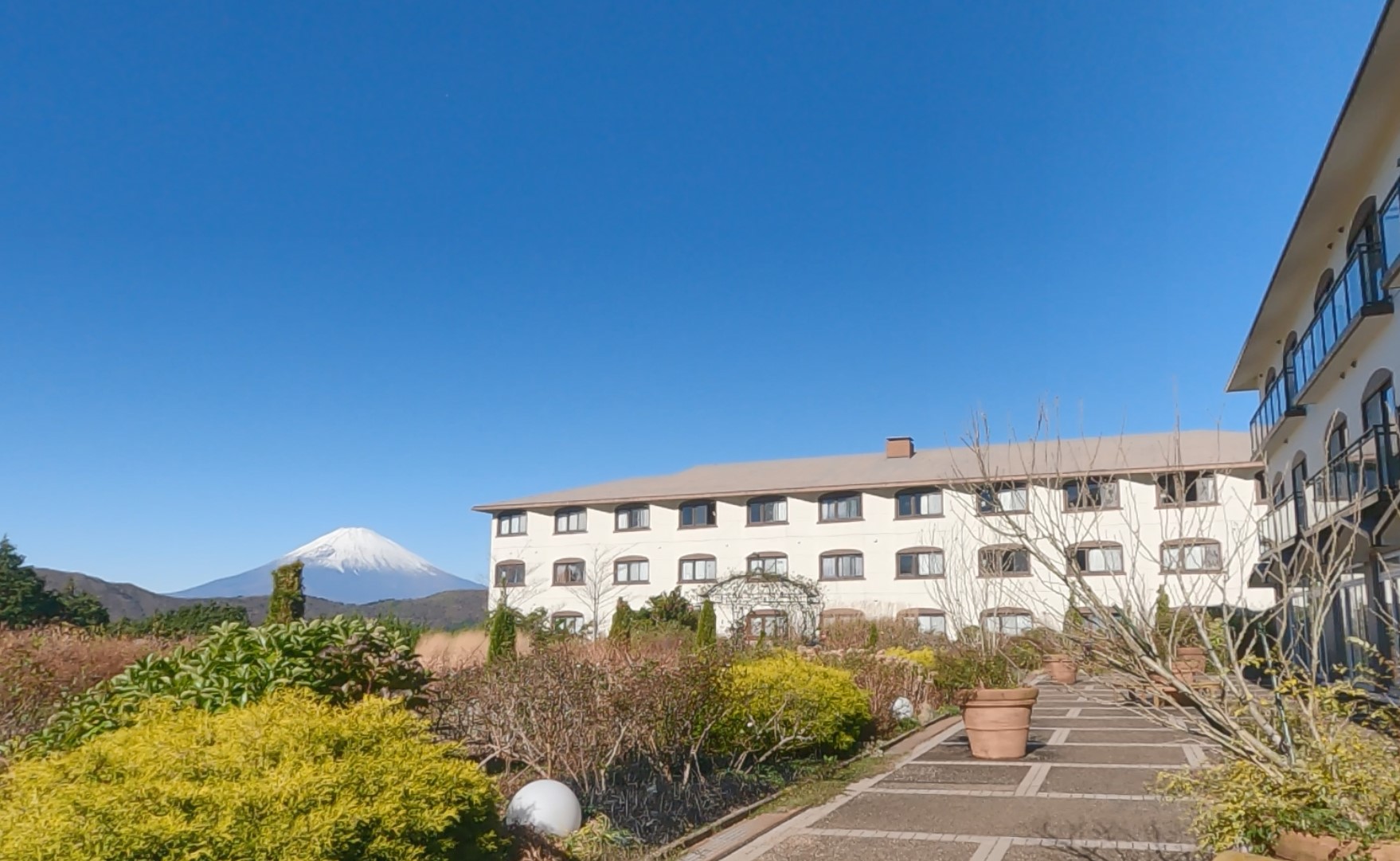
Top Ranked Hakone Hotels with Mt. Fuji View: Enjoy Stunning Scenery from Your Private Space
-
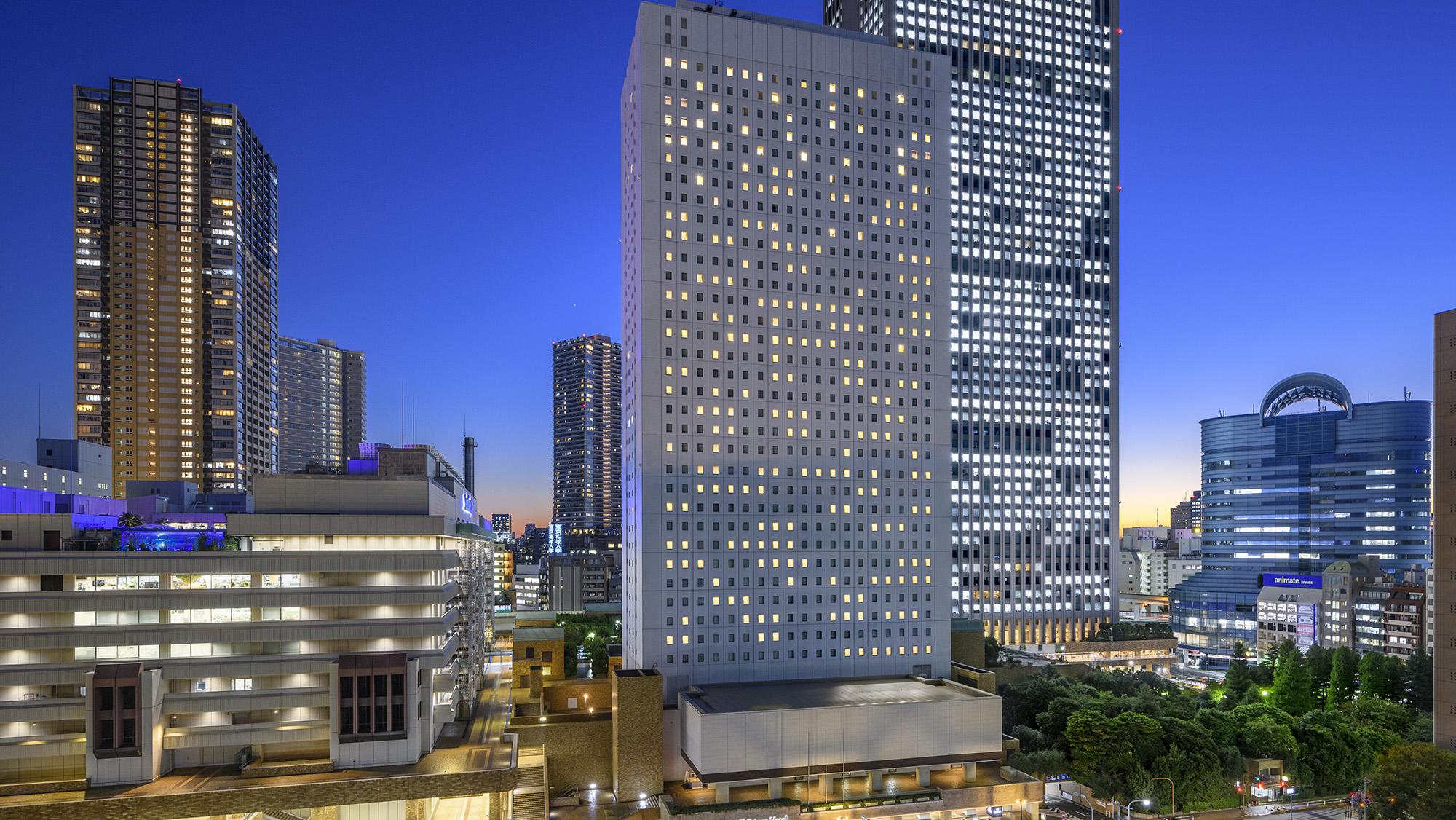
Convenient Tokyo Hotels with Airport Shuttle: Ideal for Families and Heavy Luggage
-

Stunning Tokyo Tower View Hotels: Enjoy Spectacular Scenery from Your Private Space
-

Convenient Asakusa Hotels with Kitchens: Ideal for Extended Family Visits
-

Experience Luxury: Hakone's 10 Best Five-Star Accommodations
-

Enjoy Mt. Fuji Autumn Leaves! Top Hotels Near the Popular Autumn Leaves Corridor
-

Experience Hakone Fall Foliage from Your Room with Stunning Views
-

Essential Tokyo: The Complete Guide to Ikebukuro Station
-

16 Secrets About Mt. Fuji, the Symbol of Japan: Even Japanese People Don’t Know That?!
-

Ueno Station Area Guide: Fun Ways to Explore Tokyo's Popular Destination (Area Map & Sightseeing Tips)
-

Tokyo Train Map: Your Essential Guide to Subways and Railways
-

JR Edition: Visit all of Tokyo in one Day with the Tokyo Metropolitan District Pass!
-

Numazuko Kaisho in Ueno: Good Quality, All-You-Can-Eat Seafood for Just US$12!?
- #best ramen tokyo
- #what to buy in ameyoko
- #what to bring to japan
- #new years in tokyo
- #best izakaya shinjuku
- #things to do tokyo
- #japanese nail trends
- #what to do in odaiba
- #onsen tattoo friendly tokyo
- #daiso
- #best sushi ginza
- #japanese convenience store snacks
- #best yakiniku shibuya
- #japanese fashion culture
- #best japanese soft drinks



















